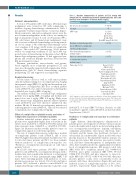Page 234 - 2021_04-Haematologica-web
P. 234
H. Al-Samkari et al.
Results
Patients' characteristics
A total of 173 patients (153 solid tumor, 20 hematologic malignancy) were treated for CIT with romiplostim to facilitate ongoing chemotherapy administration. Table 1 lists patients' baseline characteristics. Colorectal, hepato- biliary, pancreatic, and gastroesophageal cancers were the most common malignancies in the cohort, accounting for half of all patients treated. A total of 170 patients (98%; 150 solid tumor and 20 hematologic malignancy) were able to receive additional chemotherapy, receiving a medi- an of four (range: 1-36) additional chemotherapy cycles over a median of 10 (range: 2-125) weeks of romiplostim support. This totaled 60.7 patient-years (3,163 patient- weeks) of romiplostim treatment of CIT and 1,063 sup- ported cycles of chemotherapy in the entire cohort. Of the hematologic malignancy patients, 13 had aggressive lym- phoma and seven had multiple myeloma; all had known BM involvement by tumor.
Platinum, gemcitabine, temozolomide, and taxane- based regimens most commonly precipitated CIT and were most frequently supported with romiplostim. Online Supplementary Table S1 details chemotherapy regimens precipitating CIT and supported on romiplostim.
Romiplostim dosing
For the entire cohort as well as solid tumor patients only, the median starting dose of romiplostim was 3 mg/kg (interquartile range [IQR], 2-3 mg/kg) and the median opti- mized dose of romiplostim (the dose at which platelet count ≥100x109/L was achieved in patients achieving this threshold) was 3 mg/kg (IQR: 2-5 mg/kg).
The median starting dose for hematologic malignancy patients was 2 mg/kg (IQR: 2-4 mg/kg) and median opti- mized dose was 3 mg/kg (IQR: 2-5 mg/kg). Only seven (30%) hematologic malignancy patients achieved platelet count ≥100x109/L and were therefore included in this median. Of the 13 hematologic malignancy patients not achieving platelet count ≥100x109/L, only one was titrated to maximum dose romiplostim (10 mg/kg).
Effect of romiplostim on platelet counts and rates of romiplostim response in solid tumor patients
Median individual patient platelet counts on romi- plostim were significantly higher than at baseline in the entire cohort (112x109/L vs. 54x109/L; P<0.001) and in solid tumor patients alone (116x109/L vs. 60x109/L; P<0.001). Figure 2A illustrates median weekly platelet counts on romiplostim support for solid tumor patients.
The rate of romiplostim response (achieving a median on-romiplostim platelet count ≥75x109/L and at least 30x109/L higher than the pretreatment baseline) was 71% for all solid tumor patients and 82% for those patients without predictors of romiplostim non-response (see “Predictors of romiplostim non-response in solid tumor patients” below).
Of all 153 solid tumor patients, 130 (85%) achieved platelet count ≥100x109/L on romiplostim therapy, with a median time from romiplostim initiation to achievement of these values of 9 days (interquartile range [IQR] 7-15 days). After excluding patients with predictors of romi- plostim non-response (see below), 116 of 122 solid tumor patients (95%) achieved a platelet count ≥100x109/L on romiplostim therapy, with a median time to platelet count
Table 1. Baseline characteristics of patients (n=173) treated with romiplostim for chemotherapy-induced thrombocytopenia (CIT) and American Joint Committee on Cancer (AJCC) staging.
Characteristic
Age (years), mean (range)
% female AJCCa stage
Duration of chemotherapy delay
due to CIT prior to romiplostim
(weeks), median (range)
Prior chemotherapy regimens, median (range)
Cycles of current regimen prior
to romiplostim initiation,
median (range) Tumor type, N (%)
Value
60 (19-85)
45
I: 2 (1%)
II: 4 (2%)
III: 17 (10%)
IV: 128 (74%)
Not AJCC staged:b 22 (13%)
3 (1-15)
2 (1-11)
2 (1-55)
Breast 11 (6%)
CNS 15 (9%)c Colorectal 23 (13%) Gastroesophageal 18 (10%) Genitourinary 2 (1%) Gynecologic 11 (6%) Head and neck 5 (3%) Hepatobiliary 22 (13%) Lung 13 (8%) Lymphoma 13 (8%) Myeloma 7 (4%) Neuroendocrine 6 (4%) Pancreatic 22 (13%) Sarcoma 5 (3%)
aAJCC staging for solid tumors, Lugano modification of Ann Arbor staging for lym- phomas.bIncludes 15 patients with primary central nervous system (CNS) tumors and seven patients with myeloma. cPatients with primary CNS lymphoma are classified as part of this group.
≥100x109/L of 9 days (IQR 7-14 days). Statistics of addi- tional time to platelet count ≥100x109/L are listed in Online Supplementary Table S2.
Predictors of romiplostim non-response in solid tumor patients
Eight different chemotherapeutics administered to patients prior to development of CIT met criteria for inclu- sion in the multivariable logistic model evaluating predic- tors of romiplostim non-response: cisplatin, carboplatin, oxaliplatin, gemcitabine, fluorouracil, irinotecan, temo- zolomide, and the taxane class (paclitaxel, docetaxel, or cabazitaxel). In a multivariable logistic model with romi- plostim response as the dependent variable, and age, sex, biopsy-proven tumor BM invasion, prior pelvic irradia- tion, and these chemotherapeutics as independent vari- ables, three variables predicted a significantly lower likeli- hood of romiplostim response: BM invasion (odds ratio [OR] 0.029, 95% confidence interval [CI]: 0.0046-0.18; P<0.001), prior pelvic irradiation (OR 0.078, 95%CI: 0.0062-0.98; P=0.048), and prior exposure to temozolo- mide (OR 0.24, 95%CI: 0.061-0.96; P=0.043). On-romi- plostim platelet counts were considerably lower in patients with these characteristics (Figure 2B) and were reflected in rates of romiplostim response of 23%, 20%, and 46%, respectively. Taken together, 14 of 31 of these
1150
haematologica | 2021; 106(4)


